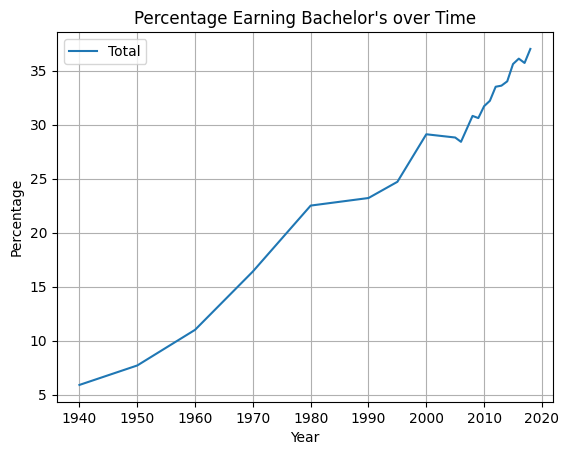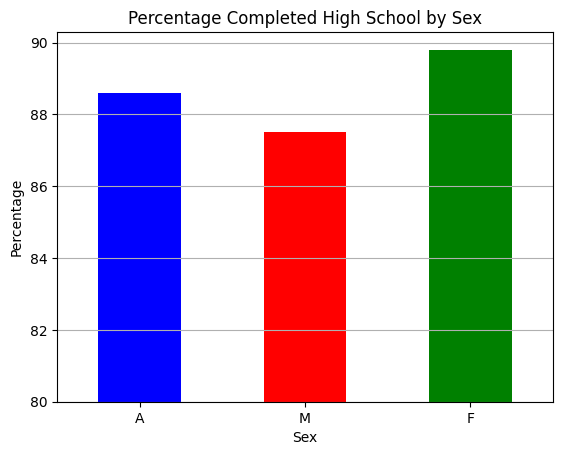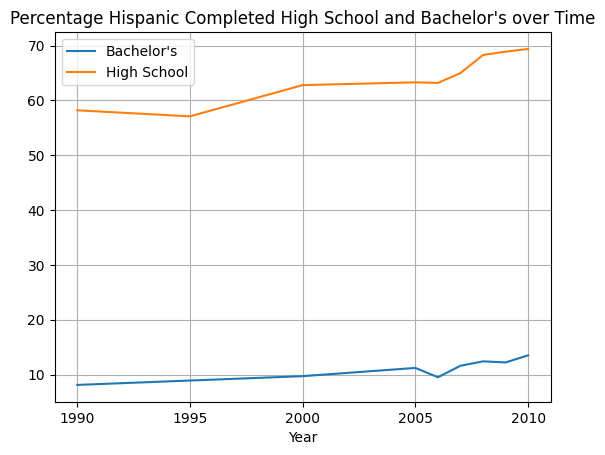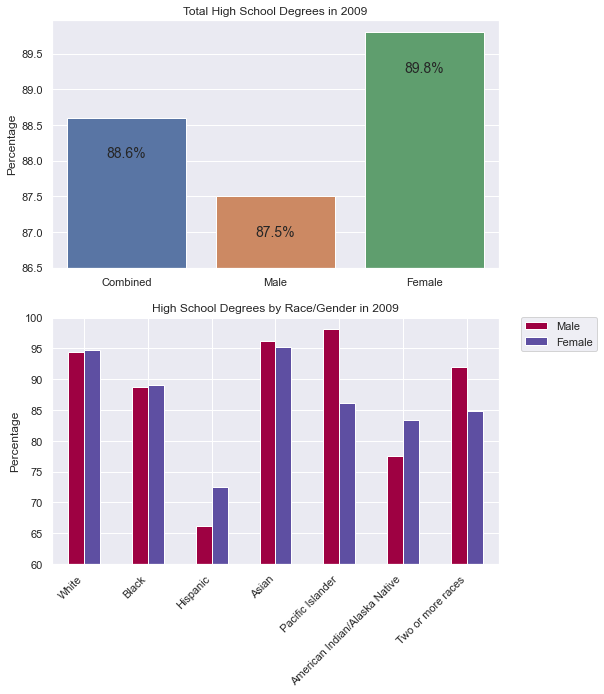HW4 - Education#
Overview#
Learning objective: Apply Pandas, Seaborn, and Scikit-learn to process, visualize, and predict outcomes about data.
Files and Tests#
nces-ed-attainment.csvis a CSV file that contains the education dataset for this assessment.hw4.pyis the file for your implementations. The Run button executes this program.hw4-writeup.mdis the file for your writeup. Instead of testing, this assessment emphasizes reflection on our data analysis.cse163_imgd_NCHS.pyis a helper file that checks your plot outputs against expected output, and creates an image showing any pixel differences. See the Image Comparison Tool tab for more information.main.pyis present simply to allow Replit Unit Tests to run.tox.iniconfigures the rules enforced byflake8. We will eliminate some rules to hopefully make development a bit easier. Do NOT submit this file because your submission will be ignored during grading. Do NOT modify this file if you wantflake8to pass during grading.expectedis a folder containing the expected output forline_plot_bachelorsandbar_chart_high_school. Don’t modify the contents of this folder.
You must submit your work as your teacher requires. Ask questions in class.
You are to submit the following two files ONLY:
hw4.pyhw4-writeup.md
Do NOT submit anything else.
You may have been given a file cse163_imgd_NCHS.py to compare the student’s
image with the expected image (provided in the expected subfolder), and generate a diff image that
is saved in the compare subfolder. Differences between the two images will be highlighted in hot pink.
You execute call the comparison using the following code:
# This is in hw4.py
from cse163_imgd_NCHS import compare_hw4_images
def main():
# All your code goes here
# then, temporarily call the comparison method
# Comment out this line before submitting
compare_hw4_images()
Context#
The National Center for Education Statistics is a U.S. federal government agency for collecting and analyzing data related to education. We have downloaded and cleaned one of their datasets: Percentage of persons 25 to 29 years old with selected levels of educational attainment, by race/ethnicity and sex: Selected years, 1920 through 2018. The nces-ed-attainment.csv file has columns for Year, Sex, Min degree, and race/ethnicity categories.
Note the missing data: not all columns have data starting from 1920! And, Our
mainmethod provides a line of code to readnces-ed-attainment.csvand replaces all occurrences of the---with pandasNaNto help with later data processing steps.
Year |
Sex |
Min degree |
Total |
White |
Black |
Hispanic |
Asian |
Pacific Islander |
American Indian/Alaska Native |
Two or more races |
|---|---|---|---|---|---|---|---|---|---|---|
1920 |
A |
high school |
— |
22.0 |
6.3 |
— |
— |
— |
— |
— |
1940 |
A |
high school |
38.1 |
41.2 |
12.3 |
— |
— |
— |
— |
— |
⋮ |
⋮ |
⋮ |
⋮ |
⋮ |
⋮ |
⋮ |
⋮ |
⋮ |
⋮ |
⋮ |
2018 |
F |
master’s |
10.7 |
12.6 |
6.2 |
3.8 |
29.9 |
— |
— |
— |
Yearis the year for the row. There may be more than one row for the same year to show the breakdowns by sex.Sexis the sex of the people for the row:Ffor female,Mfor male, orAfor all students.Min degreeis the degree of educational attainment for the row:high school,associate's,bachelor's, ormaster's.Totalis the overall percentage of people of theSexin theYearwith at least theMin degreeof educational attainment.White,Black,Hispanic,Asian,Pacific Islander,American Indian/Alaska Native,Two or more racesis the percentage of students of the specified race (and of theSexin theYear) with at least theMin degreeof educational attainment.
Warning
Do not use any loops, list comprehensions, or dictionary comprehensions. The goal of this assessment is to apply data science libraries to answer questions.
Be sure to call all of the functions you write inside your main method!
main#
Write a main method in hw4.py that loads in the dataset provided and calls all of the functions you wrote. For all of the method calls, you should rely on any default parameters we specified.
Pandas Methods#
Implement two methods compare_bachelors_1980 and top_2_2000s.
Answer the question: What were the percentages for women vs. men having earned a Bachelor’s Degree in 1980?
Write a function compare_bachelors_1980 that takes one argument, data, and finds the percentages of men and women who achieved a minimum degree of a Bachelor’s degree in 1980. The result should be a 2-by-2 DataFrame with rows corresponding to men and women and columns corresponding to Sex and Total. The order of the rows doesn’t matter. For example, your result should look something like this:
Sex |
Total |
|---|---|
M |
… |
F |
… |
Requirement
Your code should ONLY assume the structure of the data. Your code should not make any assumptions about the number of rows or where values exist. Your code should work on a different data set with different index values.
Answer the question: What were the 2 most commonly-awarded levels of educational attainment awarded between 2000–2010 (inclusive) for a given sex?
Write a function top_2_2000s(data, sex) that takes two arguments, the data and a sex parameter, and computes the two most commonly earned degrees for that given sex between the years 2000 and 2010 (inclusive). The function should return a 2-element Series. Compare educational attainment levels by using the mean. The index of the returned Series should be the Min degree and the values should be its mean. The sex parameter should default to 'A' if no sex parameter/value is provided by the caller.
Hint:
Series.nlargestworks likeDataFrame.nlargest. The Series method takes only a single integer argument and returns a Series, while the DataFrame method requires an additional column parameter and returns a DataFrame.
Here is an example: top_2_2000s(data, 'A') will return the Series shown below with index on the left and value on the right. Your values don’t have to exactly match so long as they’re within a 0.001 tolerance due to how Python represents float numbers. Because sex is set to default to 'A', this means a call to top_2_2000s(data) should also return the same Series.
high school 87.557143
associate's 38.757143
Plotting Methods#
You will NOT use Seaborn to create your plots. You will use matplotlib.pyplot only when you implement the following three methods: line_plot_bachelors, bar_chart_high_school, plot_hispanic_min_degree.
NO Seaborn
For all three plots (line_plot_bachelors, bar_chart_high_school, plot_hispanic_min_degree) there is NO seaborn allowed.
Use the following API:
df.plot()series.plot()plt.grid()plt.legend(...)plt.legend().set_visible(...)plt.xticks(ticks=...)
Do NOT use other methods of plotting.
This is to assure that the image comparison tests can work.
ChatGPT Usage Allowed
In this Homework, I’m asking you to build some specific plots. This can be difficult to do without some help with the API. Go ahead and use the internet to help out. Figure it out with AI.
IMPORTANT: Understand the code. You will be expected to replicate this kind of code on the Exam.
IMPORTANT: Do not copy from a friend. This is an exercise in looking things up and getting help from the internet. This is NOT an exercise in how to plagiarize off of a fellow student!
Write a function line_plot_bachelors that takes the data and plots a line chart of the total percentages of all people (Sex == 'A') and whose Min degree is bachelor's, graphed over time. Label the x-axis Year, the y-axis Percentage, and title the plot Percentage Earning Bachelor’s over Time.
Your plot should look like this:

Use the following line of code to save the plot:
plt.savefig('line_plot_bachelors.png', bbox_inches='tight')
Write a function bar_chart_high_school that takes the data and plots a bar chart comparing the total percentages of Sex F, M, and A with high school Min degree in the Year 2009. Label the x-axis Sex, the y-axis Percentage, and title the plot Percentage Completed High School by Sex.
Hint: When you plot using
df.plot(), use the named argmentcolor. Set the colors using the string contants,'blue', 'red', 'green'.
Your plot should look like this:

Ask yourself: Is this visualization a fair and effective plot? You will need to answer this in the
hw4-writeup.md.
Use the following line of code to save the plot:
plt.savefig('bar_chart_high_school.png', bbox_inches='tight')
Write a function plot_hispanic_min_degree that takes the data and plots how the percentage of Hispanic people with degrees have changed between 1990–2010 (inclusive) for high school and bachelor's Min degree. Create a plot that matches the plot shown below.

Use the following line of code to save the plot:
plt.savefig('plot_hispanic_min_degree.png', bbox_inches='tight')
Scikit-learn Requirement#
Train a DecisionTreeRegressor to predict the percentage of degrees attained for a given Sex, Min degree, and Year. Write a function fit_and_predict_degrees that takes the data and returns the test mean squared error as a float. Follow these specific data preprocessing and model training steps.
Preprocessing: Filter the DataFrame to only include the columns for Year, Min degree, Sex, and Total. Drop rows that have missing data in these columns—do not drop any additional rows. One-hot encode str values. Split the columns as needed into input features and labels.
Model training: Once the data has been preprocessed, randomly split the remaining data into 80% training and 20% testing. Fit the model to the training set. Finally, calculate the mean squared error of the model’s test set predictions.
The automated tests only check that the function runs without causing an error. Try comparing the ground truth values and the model’s predictions manually to check for similarity. (It would be bad if the ground truth values were [2, 755, ...] but the predicted values were [1022, 5, ...].) Also, try calculating the mean squared error on the training dataset as well as the testing dataset—the error should be lower on the training dataset than on the testing dataset.
Info
This education dataset is a time series. When working with time series, it is common to use the last rows as the test set rather than random sampling since the goal is to design a model that predicts the future. But by randomly sampling to generate the test set, we are assessing the model on its ability to predict the past! Even though random sampling is not necessarily appropriate here, we ask you to do it anyways because it’s the most common sampling method.
Markdown Writeup#
You are required to answer a few questions in the file hw4-writeup.md file. Furthermore, you are required to use some markdown that structures your answers nicely.
Markdown (which uses the file extension, md) is a relatively simple text formatting language used in many places (Wikis, Replit Instructions, Jupyter Notebooks). Markdown offers a natural-looking way to define headings, lists, and links using special characters like #.
For full points in your write-up, you MUST format with Markdown. Here is a Markdown reference. Be sure to included multiple forms of formatting such as: _italics_, **bold**, > block quotes, * bullets.
Code Quality#
Assessment submissions should pass these checks: flake8, and code quality guidelines. The code quality guidelines are very thorough.
Reminder
Make sure to provide a descriptive comments in doc-string format.
Rubric#
Rubric information can be found in the instructions in the Replit project.
Challenge Question#
OPTIONAL: This challenge question is not graded and is here for those students who already know Python and want to flex some of their intellectual muscle.
NOTE: If you implement this challenge question, you’ll need to document all methods fully with doc-strings so that all the grading scripts pass. You don’t want to have your grade drop! Be sure to test it, too!
Create a figure with two bar charts that looks like the following.

The first bar chart will illustrate by Sex the percentage who have earned a High School degree. A few things to note:
The labels for each bar are customized to ‘Combined’, ‘Male’ and ‘Female’.
There is no ‘Sex’ label on the x-axis.
The bottom of the chart starts at 86.5%.
The y-label is ‘Percentage’.
Each bar is annotated with the value of the bar.
There is a second bar chart plot in the same figure. Once again, there are some important features to recognize and replicate:
The x-axis labels are the races.
There are two side-by-side bars for Male and Female as shown in the legend.
The legend is not on top of the figure, but off to the right side and aligned with the top of the plot.
The bar labels are slanted and the end of the text aligns perfectly centered with the bars.
The bars start at 60%.
Reflect
What does this figure tell you? How can you explain it? Expand the ‘conclusions’ below to see Mr. Stride’s conclusions.
Conclusions
Females get more degrees on average, yet when we look at this graph we can see that for many of the races, males do just as well, if not better, than females. In fact, for some of the most populous races (White), females have a lower percentage of high school degrees. This should lead one to think more deeply about how females have a higher average.
One can consider Simpson's Paradox. The does NOT really apply because males do not do better in each individual category. However, it is possible that the ratio of races is different for males than it is for females.
Likely, there are a significant number of Hispanic women in the data which elevates the overall average to be ‘significantly’ larger than the Male average despite many of the races being higher for Males.
Overall, this data should beg the question: What is the ratio of races for each gender? and Why are some races doing significantly different depending on the gender?
We could do a plot over time to see if 2009 is an outlier. We’d want to see when females start to do better than males, and if that correlates to any specific race.
Annotate each bar with the value. The second bar chart will be a stacked bar chart by race for male and female, and each stacked bar will be annotated. The final figure will look like the one below.
